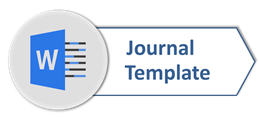Construction of Public Opinion in Online News on the Issue of Nurses’ Expulsion from Boarding House: A Critical Discourse Analysis
Abstract
Full Text:
PDFReferences
Abbas, A. H. 2020. Politicizing the pandemic: A schemata analysis of COVID‑19 news in two selected newspapers. Springer International Journal of Semiotic and Law.
Al-Afnan, M. A. 2020. COVID 19: The foreign virus: media bias, ideology and dominance in Chinese and American newspaper articles. IJALEL: International Journal of Applied Linguistics and English Literatur), 9(1), 56-60.
Albert, C. S., & Salam, A. F. 2013. Critical Discourse Analysis: Toward Theories in Social Media. Paper presented at the The Nineteenth Americas Conference on Information Systems, Chicago, Illinois.
Behera, P., & Muzaffar, S. 2015. The social media and democratic discourse: A critical discourse analysis of the power of 49 video. Asian Journal of Multidisciplinary Studies, 3(2).
Citraresmana, E., Erlina, & Amalia, R. M. 2018. Representasi TKI di surat kabar Indonesia: Kajian wacana dan kognisi melalui studi korpus. Metalingua, 16(1), 1-6.
Creswell, J. W. 2014. Research design: qualitative, quantitative, and mix-method approaches (4th ed.). California: Sage.
Dijk, T. A. 1988. News As Discourse. New Jersey: Lawrence Erlbaum Associates.
Dijk, T. A. 1993. Principles of critical discourse analysis. Discourse & Society, 4(2), 249-283.
Dijk, T. A. 1997. Discourse as Social Interaction, Vol. 2. London: SAGE Publications.
Dijk, T. A. 2007. Discourse Studies. London: Sage Publication.
Dijk, T. A. 2009. Society and Discourse: How Social Contexts Influence Text and Talk. Cambridge: Cambridge University Press.
Eriyanto. 2001. Analisis Wacana: Pengantar Analisis Teks Media. Yogyakarta: LKiS.
Fairclough, N. 1995. Critical Discourse Analysis: The Critical Study of Language. London: Longman.
Ghafur, A. 2016. Critical discourse analysis sebuah model analisis sosial kritis dalam teks media. OKARA: Journal of Languages and Literature, 2(10).
Harb, G. K., & Serhan, Y. M. 2020. Exploring the use of covid-19 as a new pre-text in Trump’s political discourse. Journal of Humanities and Social Sciences Studies (JHSSS), 2(5), 20-30.
Haryatmoko. 2016. Critical Discourse Analysis (Analisis Wacana Kritis). Jakarta: PT. Raja Grafindo Persada.
Iqbal, Z., Aslam, M. Z., Aslam, T., Ashraf, R., Kashif, M., & Nasir, H. 2020. Persuasive power concerning Covid-19 employed by Premier Imran Khan: A socio political discourse analysis. Register Journal, 13(1), 208-230.
Maghvira, G. 2017. Analisis wacana kritis pada pemberitaan Tempo.co tentang kematian Taruna STIP Jakarta. Jurnal The Messenger, 9(2), 120-130.
Malik, R. a. K. 2019. Analisis wacana Van Dijk terhadap animasi religi "Negara Islami" (Karya Cisform UIN Sunan Kalijaga & PPIM UIN Jakarta). Jurnal Komodifikasi, 7, 58-77.
Mintarsih, S. S., Kodrat, D., & Emiliasari, R. N. 2020. Tempo’s perspective on the representation of government in dealing with covid-19 cases. Journal CALL, 2(2), 125-137.
Musyafaah, N. 2017. Analisis wacana kritis model Teun A. Van Dijk "siswa berprestasi jadi pembunuh". MODELING: Jurnal Program Studi PGMI, 4(2), 192-202.
Norali, N., & Rezaei, S. 2016. Language and power: the use of persuasive techniques in Iran and U.S. President speeches. Journal of Language Teaching and Research, 7(6), 1203-1209.
Pikiran-rakyat.com (Producer). 2020. Ditelepon Ganjar Pranowo, seorang bidan menangis akui telah usir 3 perawat dari kos-kosan. Online News, accessed on May 8, 2020, 6:25pm, taken from: https://www.pikiran-rakyat.com/nasional/pr-01372802/ditelepon-ganjar-pranowo-seorang-bidan-menangis-akui-telah-usir-3-perawat-dari-kos-kosan.
Pratiwi, V. U., Nofrahadi, Pendri, A., Komalasari, D., & Sumarlam. 2020. News text on Kompas.com media of Covid-19 and the underlying conspiracy theory: A Teun Van Dijk’s critical discourse analysis. BIRCI-Journal: Budapest International Research and Critics Institute-Journal, 3(4), 3894-3903.
Septiani, A. U. 2014. The representation of major participants in Bambang Widjojanto’s arrest in The Jakarta Post articles: a critical discourse analysis. Passage, 2(3), 1-20.
Utama, G. N., & Amalia, R. M. 2019. Negative representation of Assad’s regime in CNN online articles. OKARA: Jurnal Bahasa dan Sastra, 13(1).
Wodak, R., & Meyer, M. 2001. Methods of Critical Discourse Analysis. London: Sage Publications.
Yana, D. 2015. Critical discourse analysis (CDA) of Sindo newspaper (CDA a model of Van Dijk). Jurnal Cahaya Pendidikan, 1(1).
Yanti, N. P. D. E., Putrayasa, I. B., & Artika, I. W. 2019. Analisis wacana kritis Teun A. Van Dijk pada teks pidato klaim kemenangan pilpres 2019. Jurnal Imiah Pendidikan dan Pembelajaran, 3(3).
DOI: https://doi.org/10.33365/ts.v19i1.751
Refbacks
- There are currently no refbacks.
Copyright (c) 2021 Octavia Chandra Dewi, Rosaria Mita Amalia

This work is licensed under a Creative Commons Attribution-ShareAlike 4.0 International License.
Teknosastik: Jurnal Bahasa dan Sastra
Publisher: Universitas Teknokrat Indonesia
Address: Zainal Abidin Pagaralam Street 9-11, Bandar Lampung, Indonesia
Website: https://ejurnal.teknokrat.ac.id/index.php/teknosastik/index

Creative Commons Attribution-ShareAlike 4.0 International License






